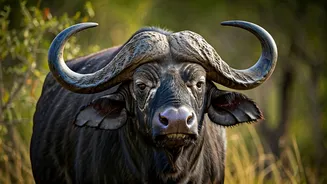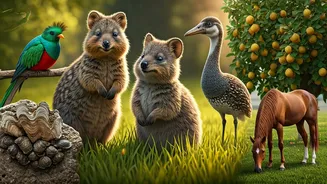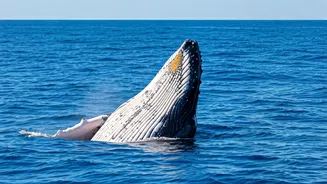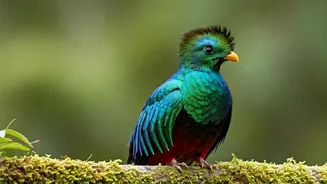Horns: Nature's Armour
Horns are truly amazing biological structures, primarily composed of keratin and, in some cases, bone. Keratin, the same protein that forms human fingernails
and hair, gives horns their strength and durability. The core of a horn is usually a bony projection from the skull, covered by a layer of keratin that grows continuously. This constant growth is a key difference from antlers, which are shed and regrown annually. The function of horns goes far beyond just display; they serve multiple purposes. They are crucial for defense against predators, used for combat within the species, especially during mating season, and help animals navigate through their environment. Different animals have evolved horns with unique shapes, sizes, and functions, reflecting their specific ecological niches and survival strategies, making them highly adapted to their surroundings.
The African Rhinoceros
Rhinoceroses are perhaps the most instantly recognizable animals with horns. These impressive horns are made of keratin, similar to hair and nails, which grow throughout their lives. Contrary to popular belief, a rhino's horn isn't attached to its skull with bone. Instead, it's a solid mass of compacted keratin fibers. They use their horns primarily for defense, both against predators and in territorial disputes with other rhinos. Their horns can be formidable weapons, capable of causing serious injury. In Africa, both the black and white rhinos are famed for their imposing horns, vital to their survival in a dangerous habitat. The rhino's horn is a key aspect of its overall identity, playing a vital role in its ecology and social interactions. Conservation efforts are now focused on protecting these iconic animals from poaching and ensuring the continued existence of their remarkable horns.
Bison and Their Horns
North American bison, massive creatures of the plains, feature thick, pointed horns that curve inwards. These horns, similar to those of cattle, are permanent fixtures on their skulls and are used for defense and social hierarchy purposes. Bison horns are sharp and sturdy, perfect for battling predators and establishing dominance within the herd. During mating season, bulls clash horns in impressive displays of strength and skill. The size and quality of a bison's horns are often indicators of health and age, playing a key role in mate selection. Beyond the physical capabilities, the horns are also a symbol of the animal’s strength and resilience, representing the survival of the species across the expansive American prairies. They are not merely defensive tools but essential to the bison's identity and life in their environment.
The Majestic Mountain Goat
Mountain goats are impressive climbers in rugged, mountainous terrains. Both male and female mountain goats have horns, which are black, slightly curved, and very sharp. Their horns are essential for a range of functions: defense from predators like wolves and mountain lions, and as tools for navigating the challenging environment. The horns play a vital role in establishing dominance hierarchies, especially among males during the breeding season. These battles often involve intense head-butting contests to determine which male will get to mate. The structure of their horns also aids in breaking through ice and snow to find food during harsh winters. The horns of a mountain goat thus demonstrate the adaptability of the animal and its incredible survival skills in an extreme environment.
The Wildebeest's Weaponry
Wildebeest, also known as gnus, are antelope-like animals native to Africa, renowned for their distinctive, curved horns. Their horns are present in both males and females, though those of the males are generally larger and more robust. Wildebeest horns are used primarily for defense against predators, such as lions and hyenas, and for combat during breeding season. The horns are sharp and well-suited for both thrusting and grappling. These structures also play a key role in the social dynamics within a wildebeest herd, helping to establish territories and hierarchies. Their horns are an essential tool for survival in the challenging African savanna, helping them to navigate their environment and protect their herds, which is necessary for their long-term survival.
The Pronghorn's Unique Horns
The pronghorn of North America is often mistakenly called an antelope, but it's the only surviving member of its family. Pronghorns are unique because they have forked horns, rather than the simple, unbranched horns of many other horned animals. Their horns, composed of a bony core covered by a sheath of keratin, are shed annually, unlike true horns. This makes the pronghorn's horns more like antlers than horns. The males use their horns in battles to defend their territories and attract mates. The pronghorn's horns are not just weapons; they are also important for communication, helping to signal dominance and fitness to other members of the herd. The distinctive nature of the pronghorn’s horns, coupled with its shedding process, makes it an evolutionary marvel.
The Ibex and Their Curve
Ibexes, wild goats found in mountainous regions of Europe, Asia, and Africa, are famous for their remarkable, backward-arching horns. The horns of male ibexes can grow to impressive sizes, often exceeding one meter in length. These horns are used for a variety of purposes: combat during mating season, defense against predators, and signaling dominance within the herd. The rings on an ibex's horns can be used to estimate its age, with each ring representing a year of growth. The size and curvature of the horns are important indicators of the male's health and genetic quality, playing a significant role in mate selection. They're a remarkable display of adaptation to a harsh, mountainous environment.
The Musk Ox Horns
Musk oxen, found in the Arctic regions of North America and Greenland, possess unique horns that curve downward and then upward, meeting in a thick, solid boss across the forehead. Both males and females have horns, but the males’ horns are larger and more developed. The dominant males utilize their horns in dramatic head-butting contests during the mating season, engaging in violent clashes to assert their dominance. The boss, or fused area, provides a solid surface for these impacts. Their horns are not just weapons; they also serve to protect the animal from the harsh Arctic environment. These structures are a testament to the Musk Ox's survival in the extreme conditions of the polar regions and demonstrate the power of adaptation.









